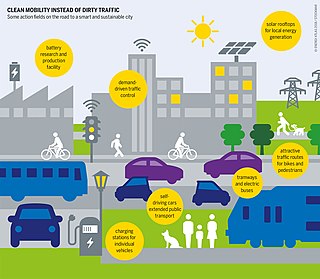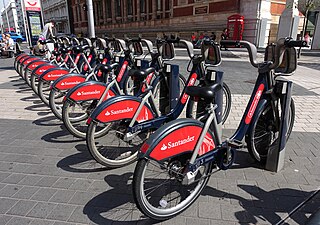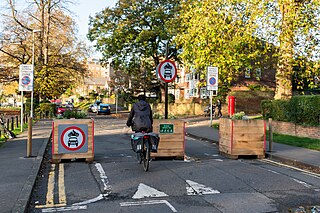Related Research Articles

Cycling, also known as bicycling or biking, is the activity of riding a bicycle or other type of cycle. It encompasses the use of human-powered vehicles such as balance bikes, unicycles, tricycles, and quadricycles. Cycling is practised around the world for purposes including transport, recreation, exercise, and competitive sport.

Utility cycling encompasses any cycling done simply as a means of transport rather than as a sport or leisure activity. It is the original and most common type of cycling in the world. Cycling mobility is one of the various types of private transport and a major part of individual mobility.

A bicycle helmet is a type of helmet designed to attenuate impacts to the head of a cyclist in collisions while minimizing side effects such as interference with peripheral vision.

Safety in numbers is the hypothesis that, by being part of a large physical group or mass, an individual is less likely to be the victim of a mishap, accident, attack, or other bad event. Some related theories also argue that mass behaviour can reduce accident risks, such as in traffic safety – in this case, the safety effect creates an actual reduction of danger, rather than just a redistribution over a larger group.

Sustainable transport refers to ways of transportation that are sustainable in terms of their social and environmental impacts. Components for evaluating sustainability include the particular vehicles used for road, water or air transport; the source of energy; and the infrastructure used to accommodate the transport. Transport operations and logistics as well as transit-oriented development are also involved in evaluation. Transportation sustainability is largely being measured by transportation system effectiveness and efficiency as well as the environmental and climate impacts of the system. Transport systems have significant impacts on the environment, accounting for between 20% and 25% of world energy consumption and carbon dioxide emissions. The majority of the emissions, almost 97%, came from direct burning of fossil fuels. In 2019, about 95% of the fuel came from fossil sources. The main source of greenhouse gas emissions in the European Union is transportation. In 2019 it contributes to about 31% of global emissions and 24% of emissions in the EU. In addition, up to the COVID-19 pandemic, emissions have only increased in this one sector. Greenhouse gas emissions from transport are increasing at a faster rate than any other energy using sector. Road transport is also a major contributor to local air pollution and smog.

Bike lanes (US) or cycle lanes (UK) are types of bikeways (cycleways) with lanes on the roadway for cyclists only. In the United Kingdom, an on-road cycle-lane can be firmly restricted to cycles or advisory. In the United States, a designated bicycle lane or class II bikeway (Caltrans) is always marked by a solid white stripe on the pavement and is for 'preferential use' by bicyclists. There is also a class III bicycle route, which has roadside signs suggesting a route for cyclists, and urging sharing the road. A class IV separated bike way (Caltrans) is a bike lane that is physically separate from motor traffic and restricted to bicyclists only.

Cycling in Melbourne is an important mode of transport, fitness, sport and recreation in many parts of the city. After a period of significant decline through the mid to late 20th century, additional infrastructure investment, changing transport preferences and increasing congestion has resulted in a resurgence in the popularity of cycling for transport. This is assisted by Melbourne's natural characteristics of relatively flat topography and generally mild climate.

Bicycle safety is the use of road traffic safety practices to reduce risk associated with cycling. Risk can be defined as the number of incidents occurring for a given amount of cycling. Some of this subject matter is hotly debated: for example, which types of cycling environment or cycling infrastructure is safest for cyclists. The merits of obeying the traffic laws and using bicycle lighting at night are less controversial. Wearing a bicycle helmet may reduce the chance of head injury in the event of a crash.

Complete streets is a transportation policy and design approach that requires streets to be planned, designed, operated and maintained to enable safe, convenient and comfortable travel and access for users of all ages and abilities regardless of their mode of transportation. Complete Streets allow for safe travel by those walking, cycling, driving automobiles, riding public transportation, or delivering goods.
A micromort is a unit of risk defined as a one-in-a-million chance of death. Micromorts can be used to measure the riskiness of various day-to-day activities. A microprobability is a one-in-a million chance of some event; thus, a micromort is the microprobability of death. The micromort concept was introduced by Ronald A. Howard who pioneered the modern practice of decision analysis.

Cycling is a popular mode of transport and leisure activity within London, the capital city of the United Kingdom. Following a national decline in the 1960s of levels of utility cycling, cycling as a mode of everyday transport within London began a slow regrowth in the 1970s. This continued until the beginning of the 21st century, when levels began to increase significantly—during the period from 2000 to 2012, the number of daily journeys made by bicycle in Greater London doubled to 580,000. The growth in cycling can partly be attributed to the launch in 2010 by Transport for London (TfL) of a cycle hire system throughout the city's centre. By 2013, the scheme was attracting a monthly ridership of approximately 500,000, peaking at a million rides in July of that year. Health impact analyses have shown that London would benefit more from increased cycling and cycling infrastructure than other European cities.

Active mobility, soft mobility, active travel, active transport or active transportation is the transport of people or goods, through non-motorized means, based around human physical activity. The best-known forms of active mobility are walking and cycling, though other modes include running, rowing, skateboarding, kick scooters and roller skates. Due to its prevalence, cycling is sometimes considered separately from the other forms of active mobility.

Santander Cycles is a public bicycle hire scheme in London in the United Kingdom. The scheme's bicycles are popularly and colloquially known as Boris Bikes, after Boris Johnson who was Mayor of London when the scheme began operating.

Cycling infrastructure is all infrastructure cyclists are allowed to use. Bikeways include bike paths, bike lanes, cycle tracks, rail trails and, where permitted, sidewalks. Roads used by motorists are also cycling infrastructure, except where cyclists are barred such as many freeways/motorways. It includes amenities such as bike racks for parking, shelters, service centers and specialized traffic signs and signals. The more cycling infrastructure, the more people get about by bicycle.

There is debate over the safety implications of cycling infrastructure. Recent studies generally affirm that segregated cycle tracks have a better safety record between intersections than cycling on major roads in traffic. Furthermore, cycling infrastructure tends to lead to more people cycling. A higher modal share of people cycling is correlated with lower incidences of cyclist fatalities, leading to a "safety in numbers" effect though some contributors caution against this hypothesis. On the contrary, older studies tended to come to negative conclusions about mid-block cycle track safety.

Controversies have surrounded dedicated cycling routes in cities. Some critics of bikeways argue that the focus should instead be placed on educating cyclists in road safety, and others that safety is better served by using the road space for parking. There is debate over whether cycle tracks are an effective factor to encourage cycling or whether other factors are at play.

Cycling in the United States is a minor sport in the country. It is also a mode of transport, particularly in urban areas.

The Mini-Hollands scheme was introduced in March 2014 by Boris Johnson, then Mayor of London. It took the form of a competition among outer London boroughs for a £100-million fund. Three boroughs – Waltham Forest, Enfield and Kingston – won £30 million each, and the remaining £10 million was shared by several other boroughs.

A modal filter, sometimes referred to as a point closure, is a road design that restricts the passage of certain types of vehicle. Modal filtering is often used to help create a low traffic neighbourhood (LTN), where motor traffic is diverted away from residential streets and instead toward feeder roads. Modal filters can be used to achieve filtered permeability within a transport network, and can encourage walking and cycling through more pleasant environments and improved safety.

In the United Kingdom, a Low Traffic Neighbourhood (LTN) is an area in which filtered permeability and traffic calming are deployed to reduce motorised through-traffic in residential areas. Many LTNs were introduced in spring 2020, although the same principles had been in use in London since the 1970s.
References
- 1 2 3 "Rachel ALDRED". Companies House. Retrieved 27 July 2021.
- ↑ "Dr Rachel Aldred : WestminsterResearch". westminsterresearch.westminster.ac.uk. Retrieved 10 June 2019.
- ↑ "Award winning researcher shifts policy mindset on cycling - Economic and Social Research Council". esrc.ukri.org. Retrieved 10 June 2019.
- ↑ Aldred, Rachel; Crosweller, Sian (1 September 2015). "Investigating the rates and impacts of near misses and related incidents among UK cyclists". Journal of Transport & Health. 2 (3): 379–393. doi: 10.1016/j.jth.2015.05.006 . ISSN 2214-1405.
- ↑ "The Near Miss Project is back! | Cycling UK". www.cyclinguk.org. Retrieved 10 June 2019.
- ↑ "Welcome to the Propensity to Cycle Tool (PCT)". www.pct.bike. Retrieved 10 June 2019.
- ↑ "Evidence session on Active travel - News from Parliament". UK Parliament. Retrieved 10 June 2019.
- ↑ "The Creative Exchange - The Near Miss Project". thecreativeexchange.org. Retrieved 10 June 2019.
- ↑ "The Creative Exchange - 5000 near misses". thecreativeexchange.org. Retrieved 10 June 2019.
- ↑ Aldred, Rachel. "Near Miss Project Report" (PDF).
- ↑ "The Progress 1000: Transport". Evening Standard. 7 September 2016. Retrieved 10 June 2019.
- ↑ "BikeBiz Women of the Year 2015: Part Two". BikeBiz. Retrieved 10 June 2019.
- ↑ "Gallery: The Total Women's Cycling Awards 2015". Total Women's Cycling. Retrieved 10 June 2019.
- ↑ Walker, Peter (11 December 2014). "Equality for all cyclists: The social justice case for mass cycling | Peter Walker". The Guardian. ISSN 0261-3077 . Retrieved 10 June 2019.
- ↑ Andrews, N.; Clement, I.; Aldred, R. (29 November 2017). "Invisible cyclists? Disabled people and cycle planning–A case study of London" (PDF). Journal of Transport and Health. 8: 146–156. doi:10.1016/j.jth.2017.11.145. ISSN 2214-1405.
- ↑ Aldred, R.; Croft, J.; Goodman, A. (25 June 2018). "Impacts of an active travel intervention with a cycling focus in a suburban context: One-year findings from an evaluation of London's in-progress mini-Hollands programme". Transportation Research Part A: Policy and Practice. 123: 147–169. doi: 10.1016/j.tra.2018.05.018 . ISSN 0965-8564.
- ↑ Aldred, R. (30 April 2018). "Inequalities in self-report road injury risk in Britain: A new analysis of National Travel Survey data, focusing on pedestrian injuries". Journal of Transport and Health. 9: 96–104. doi: 10.1016/j.jth.2018.03.006 . ISSN 2214-1413.
- ↑ "Disabled and low-income pedestrians at 'higher risk of road injury'" . Retrieved 10 June 2019.
- ↑ "Twenty times more English children could cycle to school with better transport planning". MRC Epidemiology Unit. 18 March 2019. Retrieved 10 June 2019.
- ↑ "Award winning researcher shifts policy mindset on cycling - Economic and Social Research Council". esrc.ukri.org. Retrieved 10 June 2019.
- ↑ Lloyd, Reasons to be Cheerful with Ed Miliband and Geoff. "84. ON YOUR BIKE – Reasons to be Cheerful with Ed Miliband and Geoff Lloyd – Podcast". Podtail. Retrieved 10 June 2019.
- ↑ Aldred, Rachel (April 2018). "Road Injuries in the National Travel Survey: Under Reporting and Inequalities in Injury and Risk" (PDF).
- ↑ Aldred, Rachel. "Cycling Near Misses: Findings from Year One of the Near Miss Project" (PDF).
- ↑ Aldred, Rachel. "Benefits of Investing in Cycling" (PDF).
- ↑ Golbuff, L.; Aldred, R. (25 February 2011). Cycling policy in the UK: a historical and thematic overview (PDF). London: University of East London Sustainable Mobilities Research Group. ISBN 9781905858217.